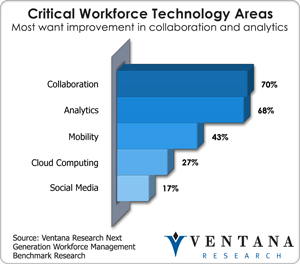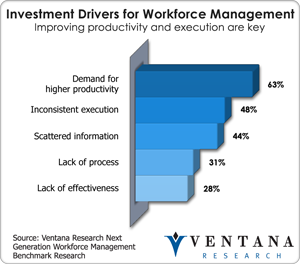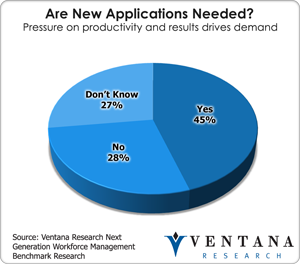Since the early ’80s, when I personally experienced the transition from written time cards to cards for swiping on a time clock at a grocery retailer I worked at, I have been interested in the software and technology of workforce management. That gives me a perspective not many analysts can match when it comes to transitioning to new technology to help organizations manage and engage workforces. Ventana Research recently completed benchmark research on next-generation workforce management, covering technologies for worker and manager environments and operations. While the research found only 10 percent of organizations at the highest level of overall maturity, which we call Innovative, we did find organizations beginning to deploy and use new workforce management technologies. While we did not distinguish in our research between hourly and salaried employees, the majority of organizations were time-clock-based organizations using technology to manage the nuances of scheduling and working with hourly-based workforces.
The research investigated a range of technologies that are changing the way businesses operate today, including analytics, collaboration, cloud computing, mobile technology and social media. Each of these plays a key role for workforce management, and sometimes in a combinatory fashion, as happens for example when workers collaborate using smartphone mobile technology or where workforce management and analytics operates in a cloud computing environment. Our research found that collaboration (70%) was the most important technology for workforce management, with analytics (68%) right behind it. Priorities can vary based on the maturity and readiness of an organization, but having ways for workers, managers and management to collaborate can drive businesses toward a more open and productive workplace.
the way businesses operate today, including analytics, collaboration, cloud computing, mobile technology and social media. Each of these plays a key role for workforce management, and sometimes in a combinatory fashion, as happens for example when workers collaborate using smartphone mobile technology or where workforce management and analytics operates in a cloud computing environment. Our research found that collaboration (70%) was the most important technology for workforce management, with analytics (68%) right behind it. Priorities can vary based on the maturity and readiness of an organization, but having ways for workers, managers and management to collaborate can drive businesses toward a more open and productive workplace.
 Organizations are pretty pragmatic when it comes to workforce management, with a large number (63%) focused on the demand for higher productivity. Many also realize the importance of improving inconsistent execution (48%) and scattered information (44%), which both result from not using dedicated applications for workforce management. Clearly the opportunity to improve is significant, but many organizations still use personal productivity tools such as spreadsheets. We found 92 percent of organizations use them universally, yet almost half (42%) find the use of spreadsheets makes it difficult to manage a workforce. More than half of organizations see assigning goals and tasks to workers (56%) as the top needed capability, followed by providing communication to resolve issues (52%).
Organizations are pretty pragmatic when it comes to workforce management, with a large number (63%) focused on the demand for higher productivity. Many also realize the importance of improving inconsistent execution (48%) and scattered information (44%), which both result from not using dedicated applications for workforce management. Clearly the opportunity to improve is significant, but many organizations still use personal productivity tools such as spreadsheets. We found 92 percent of organizations use them universally, yet almost half (42%) find the use of spreadsheets makes it difficult to manage a workforce. More than half of organizations see assigning goals and tasks to workers (56%) as the top needed capability, followed by providing communication to resolve issues (52%).
The demand for more easily defining and assigning tasks has led to a new generation of applications that let managers routinely work with their workers more directly. At the worker level, providing the basics like access to company and work information (75%), accessing training and learning classes (67%) and collaboration with others on best practices (63%) are the most important features that organizations need in their workforce management applications.
When it comes to improvement, many organizations (45%) are looking for new applications to increase productivity and drive better results. Even with the new generation of time clocks that have biometric or proximity check-in to providing information back to the workforce, from notifications to information on a new policy, there is a lot of change underway. Almost half (41%) of organizations plan to examine new technology. This mood for change and improvement extends to analytics, which almost two-thirds (61%) plan to improve over the next year. But analytics have to be available for all roles and provide not just a picture of the past but also what might happen in the future with current workers’ activities and schedules.
for new applications to increase productivity and drive better results. Even with the new generation of time clocks that have biometric or proximity check-in to providing information back to the workforce, from notifications to information on a new policy, there is a lot of change underway. Almost half (41%) of organizations plan to examine new technology. This mood for change and improvement extends to analytics, which almost two-thirds (61%) plan to improve over the next year. But analytics have to be available for all roles and provide not just a picture of the past but also what might happen in the future with current workers’ activities and schedules.
Since collaboration was the most important technology we identified for workforce management, we investigated the most important methods for future deployments in the organization. Our research found discussion forums (30%), broadcasting like Twitter (29%), application sharing (28%) and wall posting into activity streams like Facebook (27%) are the top priorities. We also found collaboration has been the most engaging when workers use mobile technology such as smartphones and tablets. Tablets have the most potential for expanding into existing and new deployments, according to 34 percent of organizations. Smartphones, while already used in two-thirds (67%) of organizations, are slated for expansion in a quarter (26%). This expansion in mobile and collaboration features indicates a new level of priority for the next generation of workforce management.
It should be no surprise that having usable applications and technology for workforce management is critical; our research found that usability was the most important technology consideration (81%). But to get that technology, setting the business case is essential, as justifying a budget for investment (63%) is the largest challenge.
Organizations that plan to upgrade or examine new applications and technologies should prioritize their needs for workforce management, considering roles of management, operations, managers and workers, and consider which methods can increase productivity and drive better results. The goal should be to address the needs of the existing and also a new generation of workers that wants to engage and use the latest technologies (mobile, social and collaborative) in their workplace.
Regards,
Mark Smith
CEO & Chief Research Officer














